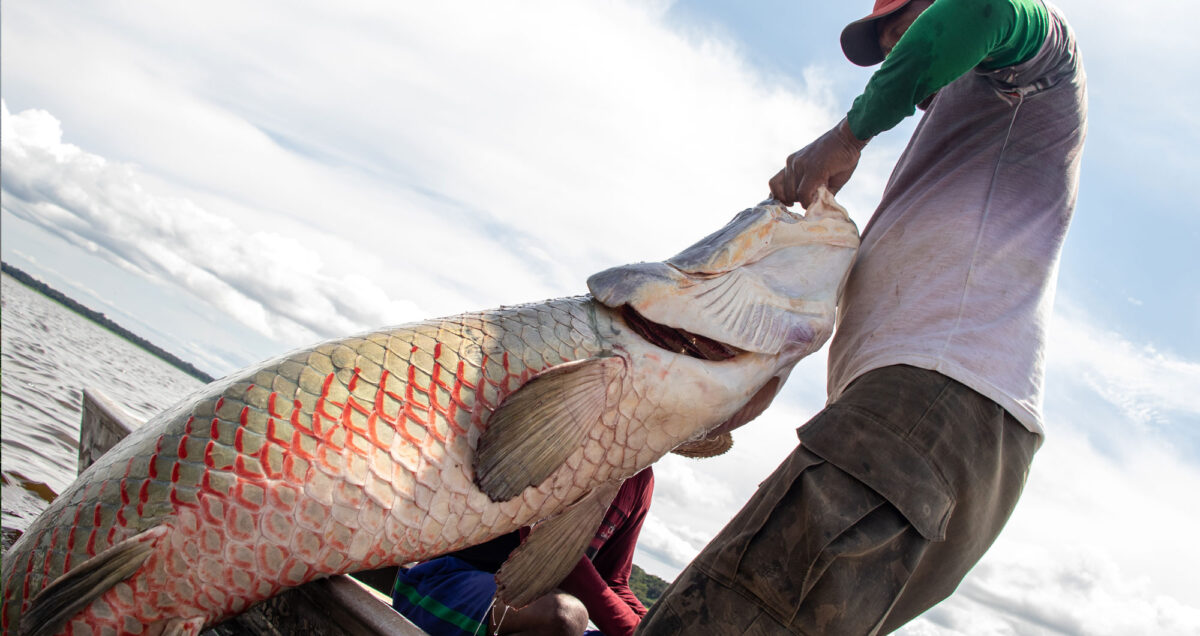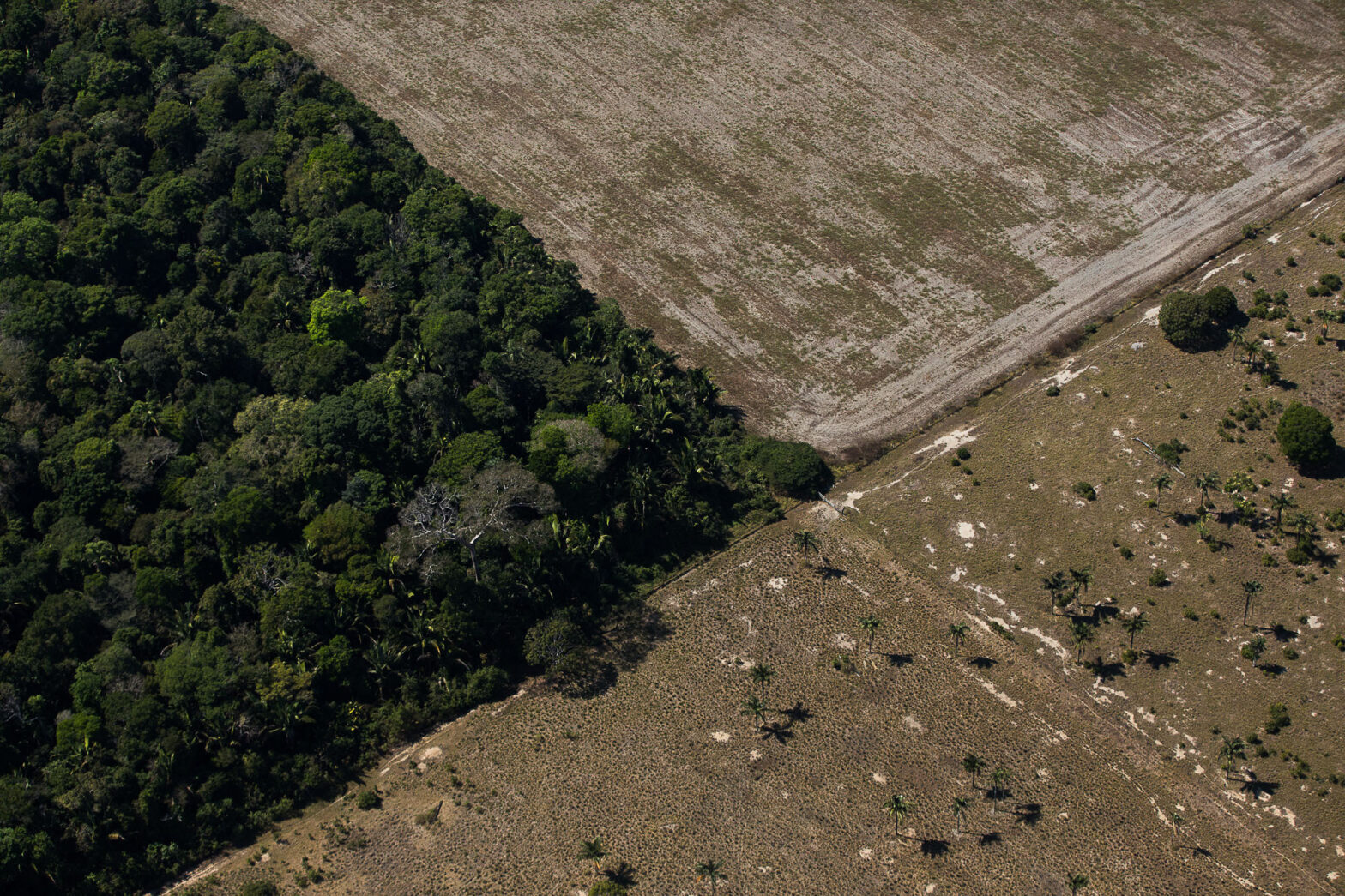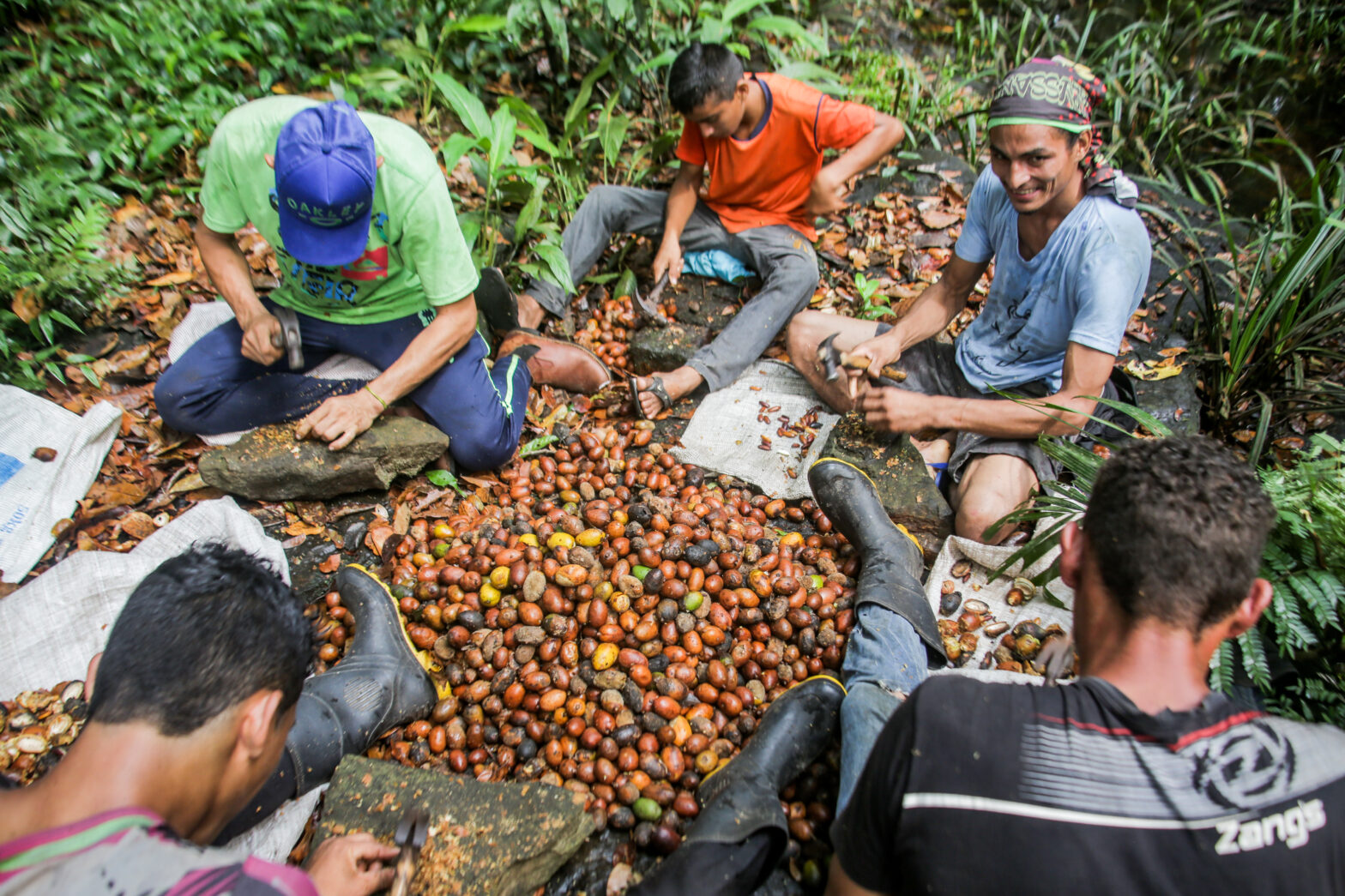Contrary to forecasts made in the 1990s, over 40 areas are guaranteeing the protection of the species without driving the pirarucu to extinction. In addition, sales of the fish provide income to fishermen, who now join a production chain that brings no harm to the Amazonian ecosystem.
The news that circulated in the inland Amazon in the 1990s was all bad. Scientific analysis indicated that the giant pirarucu, a fish known to weigh over 200 kilos, was at risk of complete extinction. The main reason was the indiscriminate fishing of the Arapaima gigas species, which lives mainly in clear-water lakes and rivers, far from large currents. The pirarucu is a typical Amazonian fish, found in the Tocantins-Araguaia basin, as well as in French Guiana.
In addition to gills, the fish has a modified swim bladder that allows it to breathe air. As such, it often comes up to the water’s surface. This behavior makes it easy prey for fishermen, since, due to its gigantic size, it is readily visible and easy to catch.
On the other hand, this behavior of rising to the surface every few minutes to breathe, which can turn out to be fatal, ended up playing a crucial role in the species’ survival. Almost 30 years later, what we are seeing in the Amazon is the successful implementation of an efficient management method, in which scientific information combined with the experience of local communities. Today, not only does the fishing production chain protect the species from extinction, it also generates income for the population.
Fishing and awareness: management
The methodology for establishing a sustainable production chain of pirarucu was developed through collaboration between scientists and residents of the Amazon. Thanks to visual observations by fishermen who count the fish emerging from the water, they are able to determine how many are present in a given lake or river. This method results in a system of rotating fishing permits each season. In other words, based on counts from members of the community, it is possible to assess whether levels of pirarucu stock is high or low, thus determining whether fishing should be allowed or forbidden in that specific area.
This work also involves rigorous oversight of the restricted lakes or rivers, but it is the local network that is actually involved in the work of avoiding overfishing. In some regions, as scientific analyses indicate, production of pirarucu meat increased by up to 400% due to the rotation system implemented between the lakes. Field observation, combined with scientific knowledge about the creature’s reproductive biology and the importance of preserving fish stocks from one breeding season to another, constitute the basis of the successful management of pirarucu in the Amazon today.
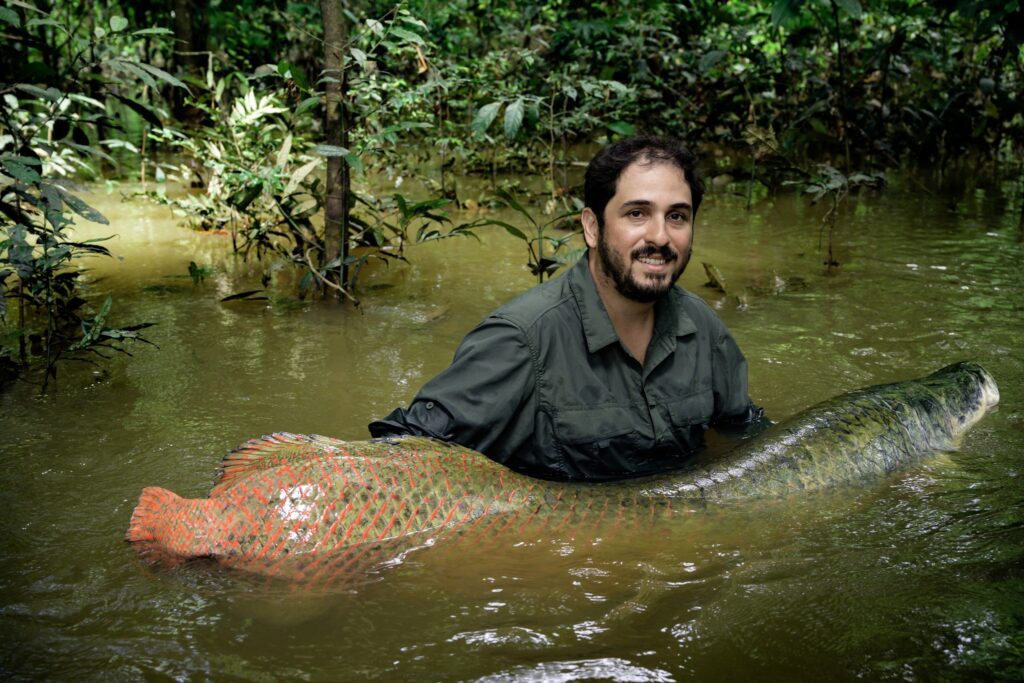
Though originally from Piedade, in the São Paulo countryside, biologist João Campos-Silva has been working in the heart of the Amazon for over 10 years. Having left southeastern Brazil to study the tropical birds in the forest, Campos-Silva is an enthusiast of the transformation caused by the community management of the pirarucu. According to the scientist, there is no “better university” to understand life than the largest tropical forest on the planet: “We have income generation and environmental preservation. Fruits of the union between traditional and scientific knowledge,” he says.
We have income generation and environmental preservation. Fruits of the union between traditional and scientific knowledge.
João Campos-Silva, biologist
Campos-Silva states that he has no doubt that the example of the pirarucu not only needs to be more widely disseminated to society as a whole, but also deserves to occupy a prominent place on any list of the main solutions for the Amazon, despite the logistical challenges faced by such products as pirarucu meat in reaching large national and international markets: “The Amazon itself holds the solution to its problems,” the biologist emphasizes.
The issue of management itself, according to the scientist, also plays a central role in terms of the Amazon’s inhabitants. He says that improving quality of life is intrinsically linked to environmental conservation. The fact that the pirarucu meat production chain contributes to effectively empowering local communities is “essential to the transformation of lives,” he argues.
Over 40 areas
According to Campos-Silva, the Amazon currently spans over 40 management areas, covering the Solimões, Jutaí, Juruá, Purus and Unini Rivers. “Among the various community initiatives, those taken by Asproc, in the middle Juruá, and Femapan, which represents the managers of the Mamirauá region, stand out.”
In the Middle Solimões, the Mamirauá Institute for Sustainable Development (IDSM), where the scientific research began in the 1990s, is one of the pioneers in the participatory management of the pirarucu, a practice that has been in place since 1999 and is overseen by the Ministry of Science, Technology and Innovation (MCTI). The institution has carried out several initiatives within the scope of its fishing program, which includes providing support to the riverside communities of the Mamirauá and Amanã reservations, as well as the surrounding cities (Tefé, Alvarães, Uarini, Maraã and Fonte Boa). The goal is to promote responsible fishing and the proper management of fish populations, with an emphasis on conservation.
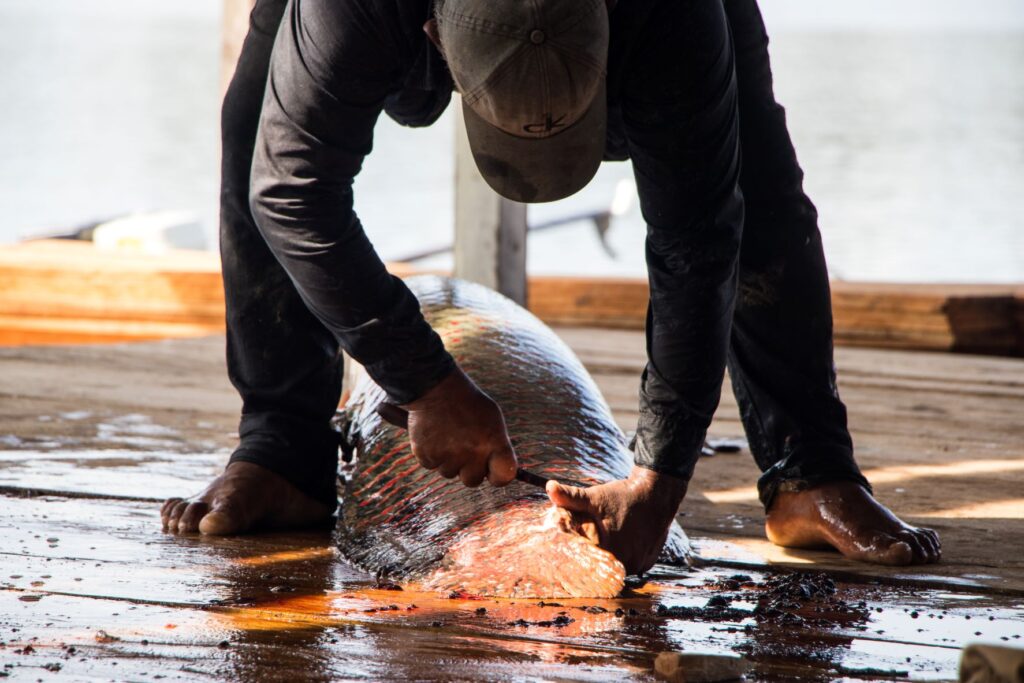
The IDSM’s current strategy is to form multipliers, that is, people who are capable of absorbing the main aspects of the fishing experiences in the region and applying them in their home locations. For example, in April of this year, 17 students from various institutions in North Brazil participated in an 11-day course entitled “Shared Management of Fishing Resources Focused on the Participative Management of Pirarucu (Arapaima gigas) in plain environments,” promoted by the IDSM Fish Management Program.
According to Ana Cláudia Torres, coordinator of the Fishing Management Program, the purpose of these kinds of initiatives, in addition to encouraging the creation of networks, is to foster the idea that the conservation of the pirarucu is intrinsically linked to the community groups’ capacity to organize. “It’s important for some people to take on the role of technical advice in the territories and it’s at this moment that these courses become essential,” the manager says.
From the Amazon to the world?
As such, with the pirarucu production chain firmly established and an increasing number of people involved in fishing each year, organized groups, such as the Carauari Rural Producers Association (Asproc), have turned their attention to the future, always striving to reach higher levels.
The most recent meeting for assessing and planning the management of the Middle Juruá lakes, held in late June, brought together 230 people, including Asproc’s managers, community-based organizations, technicians, researchers and social partners. This meeting clearly reflected the maturity of the process. On the agenda were a number of topics which pirarucu producers are hoping to advance in the near future, such as the traceability of the pirarucu in sustainable management, the ‘Fish of Change’ exportation project and the prospects for obtaining a fair trade seal.
“Everything is going well,” says Manoel Cruz, Chief Financial Officer of Asproc. According to him, the intention to export pirarucu meat is part of a project developed in collaboration with the Juruá Institute and the US Forest Service. “We have already had several meetings with the export company. The focus is on selling in the United States, but in several other countries as well,” he explains. Also, tests with pirarucu meat have already been conducted to demonstrate the viability of the product. “The results have all been positive and the expectation is that the first batch will be shipped by the end of this year.”
In terms of traceability, Cruz explains, “there are six trained professionals to begin the counting. They’re going to enter all the data into our app and, also by the end of the year, this important issue of product traceability, which is very important, will be put into practice.”
The expectations of Asproc members for 2023 are also rife with positive indicators in terms of actual production. It is estimated that 34,589 pirarucus will have been caught by November, directly involving 3,058 people in various management communities in Amazonas. In fact, the association is part of an even broader initiative, known as the Pirarucu Collective, which includes other organizations in the Amazon. In addition, it has international partnerships, with NGOs and government collaborations with such agencies as Ibama and ICMBio.
The collective was established in May 2018 with the objective of strengthening management in the Purus, Negro, Juruá and Solimões River Basins, regions located in the interior of Amazonas. Altogether, this effort has positively impacted 17 municipalities, seven extractive reserves, four sustainable development reserves, nine indigenous territories, ten areas with fishing agreements and 280 communities.
All the management of the collective business arrangement, which spans the entire pirarucu production chain, is carried out by Asproc, an organization with over 30 years of experience in the region. The pirarucu from the Amazon region is distributed all over Brazil under the brand name “Taste of the Amazon, flavor that preserves the forest.”
According to the recent survey conducted by the collective, the prices practiced in different regions for the sale of managed pirarucus range between R$ and R$10 per kilo. According to Adevaldo Dias, president of the Chico Mendes Memorial and advisor at the Carauari Rural Producers Association (Asproc), the issue of the amounts paid at the end of the chain is fundamental to sustaining the entire system.
“The work done by the association ends up acting as a market price regulator, because, by paying the managing communities more for the managed fish, it inhibits the action of poachers and explorers, and reinforces fair and supportive trade,” the expert assesses.
The work done by the association ends up acting as a market price regulator, because, by paying the managing communities more for the managed fish, it inhibits the action of poachers and explorers, and reinforces fair and supportive trade.
Adevaldo Dias, president of the Chico Mendes Memorial and advisor at the Carauari Rural Producers Association (Asproc)
While the price and the organization of the group of fishermen are fundamental steps in the production process, the issue of inspection also plays an important role, as Manoel Cruz of Asproc explains. “Each community develops its own lake surveillance system to prevent illegal fishing,” he says. There should be constant observation of the fish on a daily basis. As such, it is important that the group distributes this responsibility among the families.
Cruz also explains that the work is not only limited to vigilance, but it also involves raising awareness among everyone involved. After all, the rules established aim to preserve the species, which, in addition to providing income, is a source of food for the communities. “We have seen environmental, social and economic results for the thousands of families who are involved with the pirarucu.”
Report by InfoAmazonia for the project PlenaMata.


